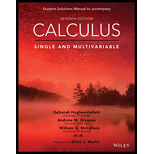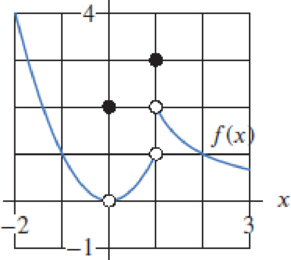Problem 1E: Use Figure 1.121 to find the limits or explain why they dont exist.... Problem 2E: Use Figure 1.122 to estimate the following limits, if they exist.... Problem 3E: Use Figure 1.123 to find each of the following or explain why they dont exist.... Problem 4E: Use Figure 1.124 to find each of the following or explain why they dont exist.... Problem 5E: Use Figure 1.125 to estimate the following limits. (a)limxf(x)(b)limxf(x) Figure 1.125 Problem 6E: In Exercises 68, calculate the limit using the limit properties and... Problem 7E: In Exercises 68, calculate the limit using the limit properties and... Problem 8E: In Exercises 68, calculate the limit using the limit properties and... Problem 9E: Using Figures 1.126 and 1.127, estimate... Problem 10E: In Exercises 1015, draw a possible graph of f(x). Assume f(x) is defined and continuous for all real... Problem 11E: In Exercises 1015, draw a possible graph of f(x). Assume f(x) is defined and continuous for all real... Problem 12E: In Exercises 1015, draw a possible graph of f(x). Assume f(x) is defined and continuous for all real... Problem 13E: In Exercises 1015, draw a possible graph of f(x). Assume f(x) is defined and continuous for all real... Problem 14E: In Exercises 1015, draw a possible graph of f(x). Assume f(x) is defined and continuous for all real... Problem 15E: In Exercises 1015, draw a possible graph of f(x). Assume f(x) is defined and continuous for all real... Problem 16E: In Exercises 1628, find the limits using your understanding of the end behavior of each function.... Problem 17E: In Exercises 1628, find the limits using your understanding of the end behavior of each function.... Problem 18E: In Exercises 1628, find the limits using your understanding of the end behavior of each function.... Problem 19E: In Exercises 1628, find the limits using your understanding of the end behavior of each function.... Problem 20E: In Exercises 1628, find the limits using your understanding of the end behavior of each function.... Problem 21E: In Exercises 1628, find the limits using your understanding of the end behavior of each function.... Problem 22E: In Exercises 1628, find the limits using your understanding of the end behavior of each function.... Problem 23E: In Exercises 1628, find the limits using your understanding of the end behavior of each function.... Problem 24E: In Exercises 1628, find the limits using your understanding of the end behavior of each function.... Problem 25E: In Exercises 1628, find the limits using your understanding of the end behavior of each function.... Problem 26E: In Exercises 1628, find the limits using your understanding of the end behavior of each function.... Problem 27E: In Exercises 1628, find the limits using your understanding of the end behavior of each function.... Problem 28E: In Exercises 1628, find the limits using your understanding of the end behavior of each function.... Problem 29E: In Exercises 2934, give limxf(x)andlimx+f(x). f(x)=x4 Problem 30E: In Exercises 2934, give limxf(x)andlimx+f(x). f(x)=5+21x2x3 Problem 31E: In Exercises 2934, give limxf(x)andlimx+f(x). f(x)=x5+25x437x3200x2+48x+10 Problem 32E: In Exercises 2934, give limxf(x)andlimx+f(x). f(x)=3x3+6x2+455x3+25x+12 Problem 33E: In Exercises 2934, give limxf(x)andlimx+f(x). f(x)=8x3 Problem 34E: In Exercises 2934, give limxf(x)andlimx+f(x). f(x)=25e0.08x Problem 35E: Does f(x)=|x|x have right or left limits at 0? Is f(x) continuous? Problem 36E: Exercises 3638, use algebra to evaluate limxa+f(x),limxaf(x),andlimxaf(x) if they exist. Sketch a... Problem 37E: Exercises 3638, use algebra to evaluate limxa+f(x),limxaf(x),andlimxaf(x) if they exist. Sketch a... Problem 38E: Exercises 3638, use algebra to evaluate limxa+f(x),limxaf(x),andlimxaf(x) if they exist. Sketch a... Problem 39E: By graphing y=(1+1/x)x, estimate limx(1+1/x)x. You should recognize the answer you get. Problem 40E: Investigate limx(1+1/x)x numerically. Problem 41E: (a) Sketch f(x)=e1/(x2+0.0001) around x = 0. (b) Is f(x) continuous at x = 0? Use properties of... Problem 42E: What does a calculator suggest about limx0+xe1/x? Does the limit appear to exist? Explain. Problem 43E: In Problems 4352, evaluate limx for the function. f(x)=x+32x Problem 44E: In Problems 4352, evaluate limx for the function. f(x)=+3xx3 Problem 45E: In Problems 4352, evaluate limx for the function. f(x)=x55+2x2 Problem 46E: In Problems 4352, evaluate limx for the function. f(x)=x2+2x13+3x2 Problem 47E: In Problems 4352, evaluate limx for the function. f(x)=x2+4x+3 Problem 48E: In Problems 4352, evaluate limx for the function. f(x)=2x316x24x2+3x3 Problem 49E: In Problems 4352, evaluate limx for the function. f(x)=x4+3xx4+2x5 Problem 50E: In Problems 4352, evaluate limx for the function. f(x)=3ex+22ex+3 Problem 51E: In Problems 4352, evaluate limx for the function. f(x)=2x+53x+7 Problem 52E: In Problems 4352, evaluate limx for the function. f(x)=2ex+33ex+2 Problem 53E: (a) Sketch the graph of a continuous function f with all of the following properties: (i) f(0) = 2... Problem 54E: Sketch the graph of a function f with all of the following properties:... Problem 55E: Sketch the graph of a function f with all of the following properties:... Problem 56E: The graph of f(x) has a horizontal asymptote at y = 4, a vertical asymptote at x = 3, and no other... Problem 57E: A patient takes a 100 mg dose of a drug once daily for four days starting at time t = 0 (t in days).... Problem 58E: If p(x) is the function on page 58 giving the price of renting a car, explain why limx1p(x) does not... Problem 59E: Evaluate limx3x2+5xx+9 using the limit properties. State the property you use at each step. Problem 60E: Let limxf(x)=andlimxg(x)=. Give possible formulas for f(x) and g(x) if... Problem 61E: (a) Rewrite 1x510x225 in the form f(x)/g(x) for polynomials f(x) and g(x). (b) Evaluate the limit... Problem 62E: In Problems 6263, modify the definition of limit on page 60 to give a definition of each of the... Problem 63E: In Problems 6263, modify the definition of limit on page 60 to give a definition of each of the... Problem 64E: Use Theorem 1.2 on page 71 to explain why if f and g are continuous on an interval, then so are f +... Problem 65E: In Problems 6566, explain what is wrong with the statement. If P(x) and Q(x) are polynomials,... Problem 66E: In Problems 6566, explain what is wrong with the statement. limx1x1|x1|=1 Problem 67E: In Problems 6768, give an example of: A rational function that has a limit at x = 1 but is not... Problem 68E: In Problems 6768, give an example of: A function f(x)wherelimxf(x)=2andlimxf(x)=2. Problem 69E: Suppose that limx3f(x)=7. Are the statements in Problems 6973 true or false? If a statement is true,... Problem 70E: Suppose that limx3f(x)=7. Are the statements in Problems 6973 true or false? If a statement is true,... Problem 71E: Suppose that limx3f(x)=7. Are the statements in Problems 6973 true or false? If a statement is true,... Problem 72E: Suppose that limx3f(x)=7. Are the statements in Problems 6973 true or false? If a statement is true,... Problem 73E: Suppose that limx3f(x)=7. Are the statements in Problems 6973 true or false? If a statement is true,... Problem 74E: In Problems 7479, is the statement true or false? Assume that limx7+f(x)=2andlimx7f(x)=2. Explain.... Problem 75E: In Problems 7479, is the statement true or false? Assume that limx7+f(x)=2andlimx7f(x)=2. Explain.... Problem 76E: In Problems 7479, is the statement true or false? Assume that limx7+f(x)=2andlimx7f(x)=2. Explain.... Problem 77E: In Problems 7479, is the statement true or false? Assume that limx7+f(x)=2andlimx7f(x)=2. Explain.... Problem 78E: In Problems 7479, is the statement true or false? Assume that limx7+f(x)=2andlimx7f(x)=2. Explain.... Problem 79E: In Problems 7479, is the statement true or false? Assume that limx7+f(x)=2andlimx7f(x)=2. Explain.... Problem 80E: In Problems 8081, let f(x) = (1/x) sin(1/x). Is the statement true or false? Explain. The function... Problem 81E: In Problems 8081, let f(x) = (1/x) sin(1/x). Is the statement true or false? Explain. The function... format_list_bulleted



